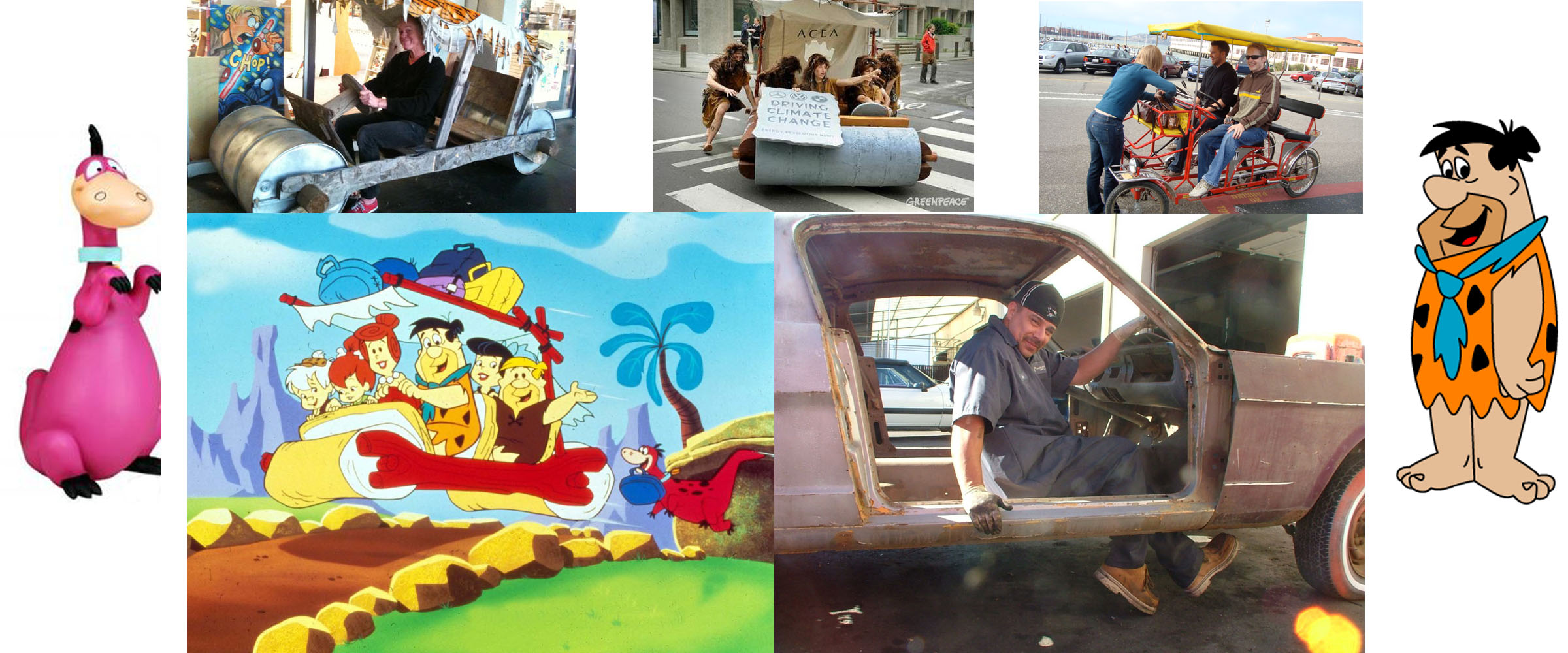
Can You Move a Car the Way Fred Flintstone Does?

 The granite-wheeled steamless steamroller pushed around by Fred Conan-quads Flintstone is number three on TIME magazine’s list of the best fictional vehicles of all time. It’s recognizable enough that it was featured on the 1994 live-action movie poster, and the iconic image of the car tipping after receiving a rack of brontosaurus (read apatosaurus) ribs is all-too familiar. There are many benefits that could be used in modern society by a human-powered vehicle, so we must turn to the beginning of the modern stone age: could someone actually move a car like the Flintstones’?
The granite-wheeled steamless steamroller pushed around by Fred Conan-quads Flintstone is number three on TIME magazine’s list of the best fictional vehicles of all time. It’s recognizable enough that it was featured on the 1994 live-action movie poster, and the iconic image of the car tipping after receiving a rack of brontosaurus (read apatosaurus) ribs is all-too familiar. There are many benefits that could be used in modern society by a human-powered vehicle, so we must turn to the beginning of the modern stone age: could someone actually move a car like the Flintstones’?
As a child, I remember trying the Little Tikes foot-powered car pictured to the right. I don’t remember it working very well, but then I wasn’t the picture-perfect image of masculine muscle I am today.
While stone car look-alikes abound on the Internet and elsewhere, most of them use materials other than granite for the wheels, lowering the vehicle mass considerably. You can even buy a functioning replica of the Flintstones’ car, but it doesn’t use the same human driving mechanism. There is an admirable group of boy scouts who regularly build wooden vehicles, but the propulsion is again done through other means (i.e. slave labour. I’m not judging, Troop 122). A real-life test of a replica may have been averted by science-hating thieves who stole it from an unsuspecting comic shop. I wanted to interview Greenpeace after they made an excursion in their own rendition of the Flintstones car, but unfortunately they were arrested.
The real heart of the problem–thank the Good Lord–comes down to a question of physics. I know you were worried it might have been something more esoteric, but you can rest assured that we’ll resolve the issue with a protractor, a slide rule and some yabba-dabba-dooduction.
There are two excellent articles which outline the reasons why Fred Flintstone couldn’t use the friction of his feet to stop a regularly-moving automobile, and I encourage you to read their toe-tickling truisms. What they haven’t done, however, is calculate the ability of a human to drive the vehicle in the first place.
I will use Scientific American’s estimates and assumptions of the car mass: namely, that it is mostly going to be comprised of the two granite slabs making up the front and rear rollers. We’ll assume the slabs are 1.5 meters long, and 0.8 m in diameter, which will make each of them have a mass of 360 kg. Add about 50 kg for the wood and tarp on top, and 95 kg for Fred himself, and you have to move a mass of 865 kg.
The maximum values for human power output are held by cyclists, with top athletes being able to pump out 6 Watts per kilogram of their own mass. If we assume Fred Flintstone was in prime shape after all those bronto-burgers, then he could generate about 570 W of power.
Thankfully the wheels make it a bit easier than trying to slide the granite across the bare ground, but even the rolling coefficient of friction isn’t going to be easy for Mr. Flintstone. Assuming a rolling coefficient of friction close to iron on granite (b=0.002 m), we calculate the rolling frictional force that must be overcome:
F = N b / R = 865 kg * 9.8 N/kg * 0.002 m / 0.4 m = 42.4 N
Power can be written as P = F x v where v is velocity. We can then solve for the maximum velocity of the vehicle under Fred Flintstone’s world-class athlete legs:
v = P / F = 570 W/ 42.4 N = 13.6 m/s
Converting this to km/hr gives us
v = 13.6 * 3.6 km/hr = 48.96 ~ 50 kph
Therefore, Fred Flintstone would be able to move at the average Canadian speed limit in cities! If additional family members helped out, then it would indeed be a feasible form of transportation. As the above-linked articles emphasize, however, the stopping distance would be much longer than the cartoon implies.
OK, the more astute of you may have noticed a glaring detail I’ve left out: how does Fred Flintstone and his family bring a dinosaur in their vehicle? That mass is significantly greater. Although Dino is officially listed as a Snorkasaur, for the purposes of this discussion we will assume he is an adolescent apatosaurus from the sauropod family. The mass of adults ranges from 16 to 22 tonnes, so we’ll assume Dino’s about 10 tonnes.
That adds 10,000 kg to the mass of the car, making it completely impractical to bring Dino anywhere. If you go through the above calculations again the additional mass makes the required force 533 N, making the speed about 1.06 m/s or 3.8 kph, about as fast as walking. But what if Dino brings his own form of propulsion?
Animals expel a fair amount of methane during the process delicately referred to as flatulation. Apparently at one point an Australian company may have been handing out carbon credits for every dead camel–that’s how stinky they are. There are suggestions that dinosaur *ahem* farts may have warmed prehistoric earth.
The estimates of an apatosaurus’s yearly methane output are about 690 kg. If we assume that sauropods outgas at about the same rate as mammals, say an average of 20 times a day, then that brings the average farted mass to about 0.095 or 0.1 kg.
The average fart is ejected at about 3 m/s. Let’s say the apatosaurus can do at least 10 times better than we can in this department, since its bowels could probably strangle a skyscraper. The momentum thus imparted by the flatulent Dino would be 3 kg * m/s. This change in momentum for the gas would result in an equal and opposite change of the entire car’s speed, of … 0.0003 m/s if we assume Dino is riding onboard.
If we neglect Dino’s mass, then the change is still only 0.003 m/s.
If we assume Dino saved up the entire year’s worth of methane for one enormous tectonic-plate shattering fart of 690 kg, that would bring the speed change to about 2 m/s, which is a more respectable change of 7 kph. That brings the total to about 11 kph, which is a little bit better than jogging, and with the entire family helping out, that could still make for a viable mode of transportation.
CONCLUSION
The Flintstone family could indeed move the granite-wheeled goliath with their own power, but they’d have to be able to exert as much wattage as Olympic cyclists. As far as bringing their pet Dino out to dinner, this must be a much-less-frequent affair than depicted on the show, and Dino would have some serious indigestion in order to expel his year’s worth of fart in one fell swoop to bring the vehicle to a respectable cruise. It would definitely not make the Flintstones friends with the neighbours, and the fact that Barney and Fred are still on speaking terms is a testament to the true power of human kinship.
If you’re interested in getting your own foot-powered cars, toy versions are available, and there is even a patent on a foot-powered vehicle, although it appears to have a mechanism different from that of the prehistoric populace. The Scooser apparently combines human power with electrical motors, though the parallel propulsion is another matter for discussion entirely (the Urbee 2 is another candidate in the same field). There’s a professor who’s done away with feet power altogether, and instead put forth rowing. You just need a team of friends whenever you want to go somewhere — no big deal.
I’ve personally tried a quad cycle with the leg power of 3 other friends, and I can attest to how tiring it can be. I put forth that the Flintstones didn’t live in San Francisco, but more likely Saskatchewan.

Were the Flintstones on the verge of developing human-powered flight with their thunder thighs? (Image of the Gossamer Albatross)










If indeed Dino weighed 10 tonnes why not just throw a saddle or harness on him and let him “pull his own weight” as it were and also thereby alleviate what would otherwise be an awful lot of crowding in the vehicle? And cross your fingers he DOESN’T emit any methane.
But in later episodes he doesn’t seem to be all that large and could more easily ride as a passenger. So I’m sure a recalculation with his mass more like that of a medium-size doggie would yield a more reasonable result.